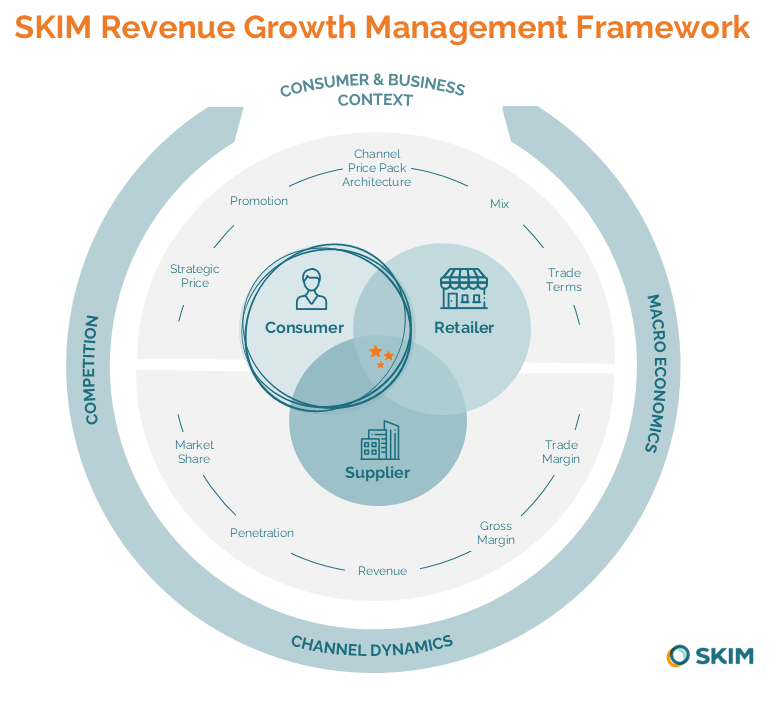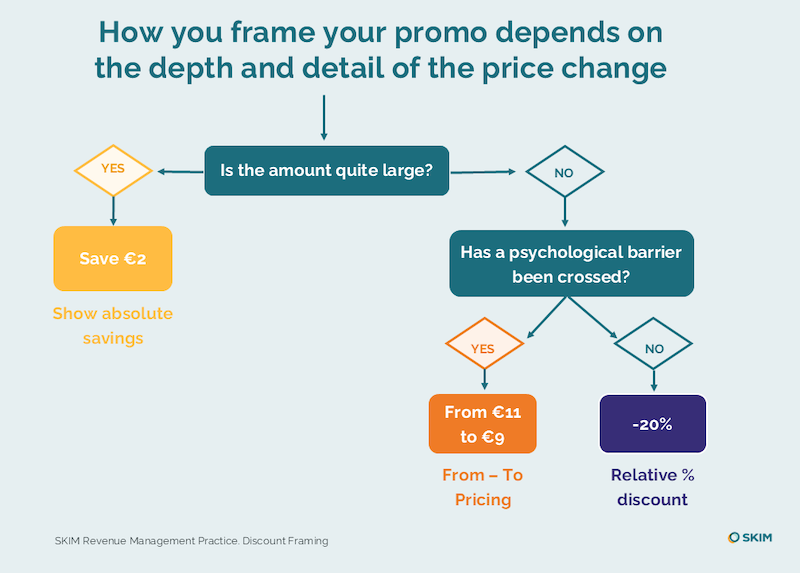By Jessica Edwards, Vice President, Revenue Management, SKIM
 After years of inflation, shoppers are becoming resistant to price increases. If you’re responsible for CPG/FMCG brands, you’ve likely seen consumers jump ship and are feeling the pressure to dial up promotions to increase sales this year.
After years of inflation, shoppers are becoming resistant to price increases. If you’re responsible for CPG/FMCG brands, you’ve likely seen consumers jump ship and are feeling the pressure to dial up promotions to increase sales this year.
But promotions are expensive and can take a big bite out of your profits.
So how can you create the right promotion strategy to entice consumers back to your brand, without sacrificing your bottom line?
The key to optimal promotion strategies which drive incremental value is understanding and predicting consumer behavior. The SKIM revenue management practice recently conducted new research to explore these shifting price perceptions in Europe.
Read on to learn these insights and uncover the promotional “sweet spot” that creates a win-win-win for your company, retailer and consumer.
The challenge: Disrupted consumer decision behavior and new habits
The financial pressures of the post-pandemic economy have disrupted consumers’ purchase habits. Shoppers have been forced to make new choices.
According to McKinsey and Euro Commerce, years of price hikes have resulted in:
- Consumers are cutting back on volume purchases and trading down to lower-priced brands.
- Consumers are actively looking for more ways to save money.
- Retailers are demanding price cuts and governments are creating regulations to push prices down.
The message is clear. While inflation has slowed, costs remain high.
How can brands navigate this environment and drive growth?
Design a winning revenue management strategy
For revenue management and pricing teams, winning in 2024 means crafting a revenue management strategy that meets the needs of all stakeholders: shoppers, retail partners and your own bottom line.

The trick to finding that “sweet spot” is using a data-driven and customer-centric approach to understanding and predicting consumer behavior in your specific category. And the same holds true for one of the key levers in a solid revenue growth strategy – promotions. The key to success is identifying the optimal mix of promotions that resonate best with target customers and contributes to sustainable revenue growth.
3 consumer trends: Current impact of FMCG pricing and promotions on purchase decisions
As a partner to the world’s leading brands and revenue management teams, SKIM set out to explore the current consumer mindset, including shoppers’ attitudes and behaviors related to pricing and promotions. We interviewed over 1,500 European consumers across food, personal care and household care categories.
Three key trends emerged from our consumer pricing research:
1. Price sensitivity is growing across all categories and generations.
Consumers are more cost-conscious in their shopping behavior due to the current economic state. With a heavy strain on their budget, the absolute price is more important than ever.
Unsurprisingly, limited budget is the No. 1 situation when promotions come into play.
Shoppers are paying attention to price-per-volume to the point where they’re doing the math at the shelf – both at brick-and-mortar channels and online.

- In household care, this can be both a challenge and an opportunity in the context of multipack promotions. These shoppers are looking for value in categories where they can’t reduce consumption.
- In personal care, we heard that large sale days, like Amazon Prime Day, were quite important.
2. Promotions can heavily attract and convert shoppers, but motivations differ across generations.
Two-thirds of consumers said promotion is one of the top three important considerations when assessing products and that they often lean toward waiting for a promotion to make their purchase. While promotions can be highly effective in attracting and converting shoppers, the mechanics matter.
We uncovered nuances across categories that influence price sensitivity and behavioral responses towards promotions. Understanding these generational insights will help you determine the pros, cons and timing of each promotion type – i.e., buy one get one, multi-buys, direct discounts and free gifts.

For example, we found:
- In-store events with free samples and free gifts are very influential with Gen Z. These promotions emphasize product benefits (experience) and were the No. 1 conversion tactic.
- Household care had the lowest propensity to wait (54%) for promotions, highly driven by Gen Z/Y. Whereas in personal care, we see that Gen X is more likely to wait for a promotion.
It’s important to align your promotions goals, mechanics and scheduling with shopper motivations.
3. Trade down is becoming a reality.
Nearly one third of consumers are opting for private label brands. However, the risk of down trading is not the same for all shoppers in all categories.
- Personal care shoppers are less likely to trade down than those in other categories.
- Gen X and Gen Y buyers have a higher tendency to trade down than older or younger generations.
- Consumers who have purchased private label in the past are more likely to trade down.
How can you entice these consumers back after lapsed purchases?
62% say promotion/discount is the most likely tactic to bring them back from private label.
How to bring consumers back from private label with promotions
Before exploring how to fend off private label brands, it’s important to understand the behavioral science concept behind “anchors,” and how they influence shopper purchase behavior.
An anchor is a reference point, often a known price, that consumers use to compare and make purchase decisions. Consumers latch onto these anchors, which are formed arbitrarily, but become rigid and resilient once established. Private label brands often provide consumers with a low anchor.
Promotions are one way to conquer private label anchors – and drive conversion.
If consumers are already anchored to your private label competitors’ low prices, use promotions to meet the anchor. This approach brings your price closer to their anchor, while maintaining the brand perception of premium. While the need to lower prices can limit value growth potential, when planned strategically it can be a powerful way to grow volume.
Direct discounts can be very attractive to these shoppers. However, how you articulate your promotional discount can make or break your ability to attract consumers back to your brand.
Depending on the depth and detail of the price change, options include:
- Absolute savings.
- Percentage discount.
- Dipping under a psychological price barrier.

Takeaway: 4 questions revenue management teams need to know
Choosing effective pricing and promotions requires meaningful behavioral intelligence about your consumers — knowing how they will respond to potential promotion strategies. Digging deeper to understand the nuances of your own category and shoppers is key.
Here are four questions your team should be asking to help guide revenue management and promotions decisions:
- What are consumers’ (changing) priorities and what motivates them to change their purchase habits?
- What absolute price points are most compelling and to which specific shopper segments?
- When and which consumers are willing to wait for a promotion to purchase?
- Which promotions sit in the “sweet spot” for greatest impact?
We would like to thank Tom Holloway, Behavioral Science Lead Analyst at SKIM, for his authorship of “Beat private label brands: Winning strategies to conquer anchors.”
